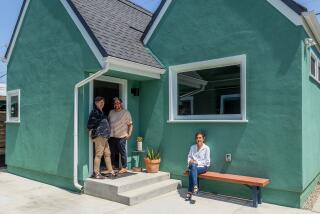Helping seniors live at home longer
Patricia McGinnis has six brothers and sisters who help her take care of their 89-year-old mother. Though their mother is alert and able to live on her own, she is blind and has balance problems that have led to several falls, for which she has received care.
It takes all of the siblings working together to help their mother stay at home. But every day, as president of the California Advocates for Nursing Home Reform, McGinnis deals with people who don’t have that choice and must live in nursing homes because they lack the financial resources or social support to remain at home as they age.
Home-based care is increasingly seen as a legitimate and less costly alternative to nursing home care. The Patient Protection and Affordable Care Act, signed into law by President Obama in March 2010, includes provisions to assist people who want to stay in their homes longer.
“I think it’s probably one of the most important reforms to long-term care since Medicare and Medicaid went into effect in 1965,” McGinnis said. “This is imperative, so I am really excited about it.”
About 1.5 million people live in nursing homes in the U.S., according to the Centers for Disease Control and Prevention. And more than 10 million Americans — mostly people 65 or older — need long-term services and support to help them with daily activities, according to the Kaiser Family Foundation.
Elinor Ginzler, senior vice president for livable communities at AARP, said the organization is always fighting for more funding to help people stay in their homes longer.
“Nursing homes are not a first choice,” she said. “People like where they are living. We surveyed the 50-plus population and found that 86% of them want to stay in their homes.”
One of the main reasons is financial.
The cost of staying at a nursing home ranges from about $40,000 to $85,000 a year, according to a recent report by John Hancock Financial Services Inc., an insurance and financial services company. The average cost of a home health aide, on the other hand, is about $37,000 a year.
A long-term care insurance policy McGinnis purchased some time ago pays for most of her mother’s healthcare at home. But not everyone has that kind of insurance. “If you look at the baby boomers coming up, I wonder how we are going to pay for all of this,” she said. “The average retirement savings of people 55 or older is $29,000 a year.”
New provisions of the Affordable Care Act should help. The most ambitious part of the act to do with long-term care is the Community Living Assistance Services and Supports Act, or CLASS — a voluntary, consumer-financed insurance plan to cover long-term care expenses.
“It is a really different and new way of looking at the delivery and financing of long-term care in the U.S.,” said Dee Mahan, deputy director of health policy at FamiliesUSA, a nonprofit healthcare advocacy organization. “I think the program is really, really important.”
The insurance plan is similar to those currently available in the private market, but there are a few major distinctions. First, the program will be administered by the government. Second, any working adult age 18 or older will be able to enroll, regardless of any preexisting medical condition, and benefits will be good for as long as someone needs long-term care.
And unlike most private long-term care insurance plans, which restrict how money can be used, the government plan will offer benefits that could be used for a wide variety of expenses including hiring a home care provider and doing home modifications.
Before receiving daily cash benefits through the government program, people will have to pay premiums for at least five years and work for a minimum of three of those years. The benefits will be calculated based on the degree of disability or cognitive impairment. Although the average daily benefit won’t be defined until October 2012, the law states that it must be no less than $50, and it is expected to be about $75, according to a Congressional Budget Office report.
Employers that take part in the program will automatically enroll their employees, who will be able to opt out. Others will be able to enroll individually.
The cost of premiums has yet to be determined, but it will depend on age and will be cheaper for younger people. The cost for low-income individuals and full-time students will start at $5 a month. The plan will be funded entirely through premiums — one of its only flaws, Ginzler said.
“CLASS runs the risk of not being implemented optimally,” she said. “For it to work, you have to have a large pool of people paying into the system. And the reality is that most people don’t want to think about their need for long-term care; they would rather plan for their funeral than their disability.”
Other provisions in the Affordable Care Act will also help individuals stay in their homes longer if they choose.
Expanded spousal impoverishment protection: Before receiving Medicaid assistance for nursing home care, individuals must first “spend down” their assets to an amount set by the state (essentially, impoverishment). However, home-dwelling spouses of individuals who receive Medicaid assistance at nursing homes can retain a certain amount of income and assets to protect these couples against total financial ruin.
The same protection does not apply to the spouses of individuals receiving Medicaid for home-based services — but the Affordable Care Act has a provision that allows individuals to get Medicaid assistance for home- and community-based care without forcing their spouses to spend all of their assets. The provision will go into effect in 2014 and will last for five years.
“Community-first choice option”: According to FamiliesUSA, 35 states provide home- and community-based care services through Medicaid. When budgets are tight, however, these services are among the first to get cut, Ginzler said. The “community first” option, available to states starting this October, is intended to expand these programs through a 6% increase in the amount of matching funds the government offers to states for the cost of these services.
Money follows the person: A demonstration project is helping people on Medicaid leave nursing homes and return to their communities. It offers case management services and assistance with home modifications, one-time housing expenses and help with other costs associated with this transition. To be eligible for benefits, people were required to live in nursing homes for at least six months; the Affordable Care Act stipulates that they need to stay there only 90 consecutive days. It also extends the project for five years.
Balancing incentive payments program: This program, which will run from October through the end of September 2015, will increase federal matching funds by up to 5% for state Medicaid programs that provide home- and community-based care. The program will apply to states that currently spend less than half of their Medicaid funds for long-term services on noninstitutional care. The plan will also help states increase access to long-term services and standardize eligibility criteria.
More to Read
Sign up for The Wild
We’ll help you find the best places to hike, bike and run, as well as the perfect silent spots for meditation and yoga.
You may occasionally receive promotional content from the Los Angeles Times.






